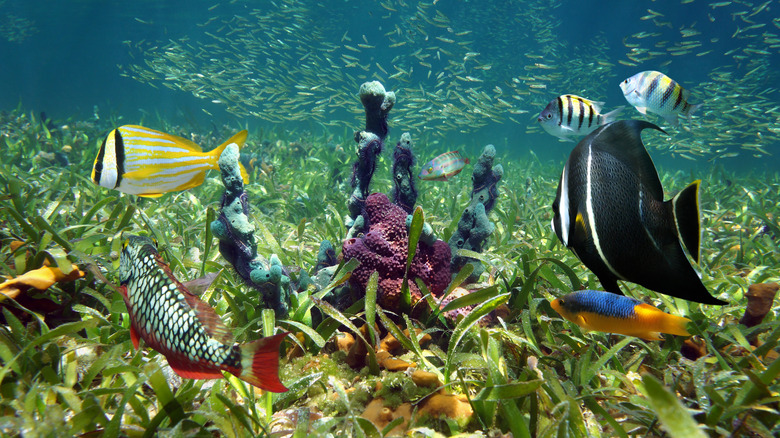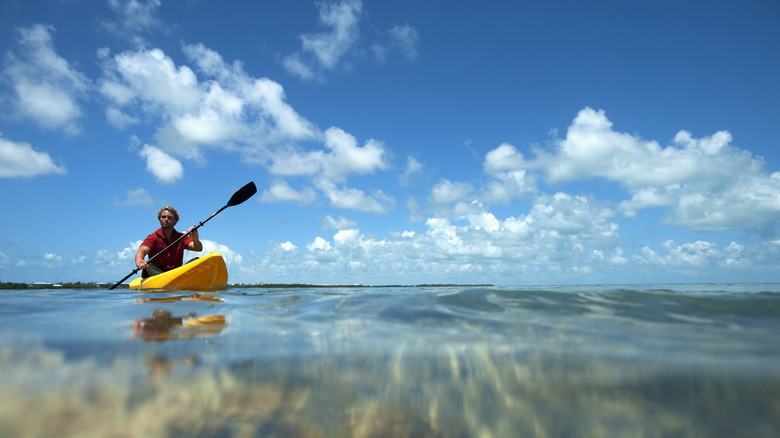Florida's Top Sea Life Preserve Is A Stunning Gulf Coast Eco-Park With Boating, Fishing, And Wildlife Viewing
Florida boasts a combined 8,400 miles of coastline, including nearly 5,100 miles along the Gulf of Mexico. As the shore reaches north and eventually curves west into the Florida Panhandle, the landscapes and ecosystems shift to salt marshes, clear natural springs, undeveloped beaches, and tangled, old-timber forests. Known as the Big Bend region, this north-central coast has a distinct natural flavor, best experienced by taking a road trip up the Big Bend Scenic Byway through forgotten Gulf forests and past uncrowded beaches. Offshore floats one of Florida's ecological gems: The Big Bend Seagrasses Aquatic Preserve.
Designated in 1985, the preserve spans five Florida counties and 984,000 acres along more than 150 miles of protected coastline, yet it's only a fraction of the roughly 2.5 million acres of seagrass beds throughout coastal Florida. At least five major species of seagrass — Cuban shoal grass, manatee grass, turtle grass, star grass, and widgeon grass — grow throughout the preserve, making it one of the most continuous seagrass ecosystems in the eastern Gulf. With such a vast coastal reach both above and below the water, this sanctuary creatives diverse ecological habitats, from oyster reefs to salt marshes to blackwater estuaries, and hosts teeming wildlife from manatees to pink shrimp to migrating birds. It's also a haven for humans to boat, fish, paddle, and get up close to Florida's wild side. While Florida continues to face complex decisions around coastal development, land conservation, and water quality, this stretch of protected sea quietly thrives.
Why is seagrass so important?
Seagrasses grow in shallow, brackish waters and thrive in protected areas like coves, lagoons, and bays — places with abundant natural light. Though they can be mistaken for seaweed, they're more like land plants with roots, leaves, and flowers. Long, green blades form dense underwater meadows — some so large they can be seen from outer space — and stretch from the sea floor up to the water's surface. Seagrass meadows are considered some of the most productive ecosystems, and serve as marine life nurseries, incubating scallops, trout, crabs, manatees, and sea turtles, and supporting the aquatic food chain, vital anchors of Florida's fishing economy.
A number of boat launches are available in the region, some for nominal fees, and several local operators offer eco-tours and fishing charters. Try Florida Saltwater Flats Fishing Charters out of Steinhatchee Marina or Reel Epic Charters out of Keaton Beach. Econfina Sporting Club, specializing in scallop fishing, and Southern Escape Charters also run a variety of tours in the Big Bend area. If you're navigating with your own boat, avoid anchoring or motoring through the seagrass beds to help preserve these sensitive ecosystems. Under Florida law, you can incur steep fines for damaging these aquatic species.
Unfortunately, many seagrass beds have been damaged by pollution, boating, development, and warming waters. The same issue is occurring in places like the Caribbean, where unchecked nutrient runoff has fueled sargassum algae growth, creating massive blooms that threaten marine life and the region's pristine beaches. Protecting Florida's seagrass meadows through preserves like Big Bend is essential. These ecosystems not only support biodiversity and local economies but also help restore balance to the oceans and climate.
How to explore the Big Bend Seagrasses Aquatic Preserve
The Big Bend Seagrasses Aquatic Preserve isn't your typical park. There are no gates or visitor centers. Instead, the undeveloped Gulf coastline offers shallow, protected waters perfect for paddling, fishing, wildlife watching, and even snorkeling. It's one of Florida's most pristine natural escapes, best explored by kayak or canoe. The preserve even includes a 105-mile segment of the Florida Circumnavigational Saltwater Paddling Trail, which stretches around the entire Florida peninsula.
Paddlers can take on multiday adventures with primitive camping or enjoy easy day trips, keeping an eye out for dolphins, manatees, sea turtles, scallops, bald eagles, and wading birds. You can use the 50-page Big Bend Saltwater Paddling Trail Guide to help map out a paddle trail and plot side quests and overnights on land. Launch from Horsehoe Beach, which has a volleyball and basketball court, baseball field, beach, and picnic pavilion, or from Keaton Beach, Suwannee River, or Econfina River State Park. If you don't have gear, local outfitters offer rentals and guided tours all along the coast. Try River Inn and Marina in Steinhatchee for rentals and Suwannee Guides, which offers rentals and guided tours.
While the preserve is entirely marine-based, it's surrounded by public lands like Cedar Key Scrub State Reserve, Lower Suwannee National Wildlife Refuge, and Waccasassa Bay Preserve State Park, a scenic salt marsh haven for sea turtles, offering hiking trails, boardwalks, and boat access. The best time to visit is from November to April to avoid hurricane season and the worst of the mosquitoes.


